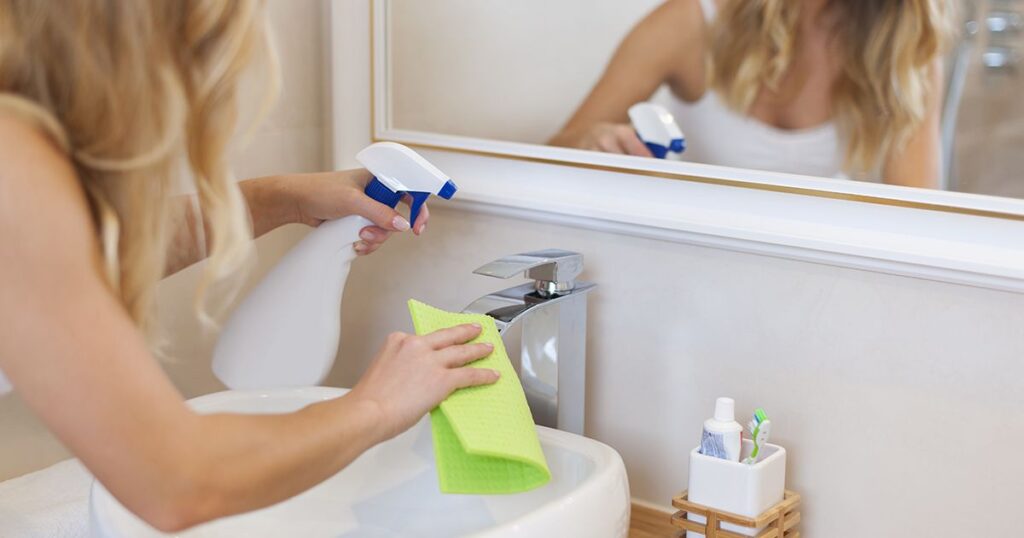Introduction
Bathrooms can go from sparkling to shockingly grimy in what seems like no time at all. Just think about all the steam, splashes, and(…well, let’s not get into that) a bathroom endures in a single day. It’s no wonder these high-moisture areas quickly become a breeding ground for mildew, soap scum, and other unsavory buildup.
However, an effective deep clean regularly can keep even the hardest-working bathroom looking and smelling fresh. This comprehensive guide covers when, why, and how to clean a bathroom thoroughly for a truly refreshed, welcoming space.
How Often You Should Clean the Bathroom
While a quick daily wipe-down of high-touch surfaces is ideal, most experts recommend a complete bathroom cleaning every 7-10 days. This helps prevent more giant messes from building up and becoming difficult to tackle. However, the optimal frequency can vary based on factors like:
- Household size and usage (a half-bath used only by guests won’t need as frequent cleaning as a family’s main bathroom)
- Surface materials (porous tile and grout may show buildup faster than non-porous surfaces)
- Ventilation (humidity buildup leads to quicker mildew growth if not properly vented)
Be sure to dig in before your bathroom is soiled. Sticking to a routine deep clean schedule is best for maintaining cleanliness with less elbow grease.
A Few Things to Remember While Cleaning Your Bathroom

1. Clean Dry Before You Clean Wet
Trying to clean wet, soiled surfaces is futile – all you’ll do is spread the grime around more. Start by dusting and removing any dry debris, hair, and dirt first. That way, when you get to the wet cleaning products, they can tackle what’s left behind more effectively.
2. Save the Disinfectant for Where It Matters
While we all want a sanitized and clean bathroom, dousing every surface with disinfectant is unnecessary. These harsh chemicals should be reserved for areas most prone to bacteria buildup, like toilets, bath mats, and anywhere with visible mold/mildew. Using disinfectants everywhere is wasteful and exposes you to more harsh fumes than needed.
3. Don’t Forget to Declutter
An organized, clutter-free bathroom means less surface area for accumulating dirt and grime. Take a few minutes before each cleaning session to remove any countertop items, empty trash cans, and fabric items like bathmats and towels. This gives you clear access to all areas for thorough cleaning.
4. Gather Your Cleaning Arsenal
Having the right tools and bathroom cleaning supplies makes the job much easier. Some essentials include:
- Vacuum with hose attachments
- Microfiber cleaning cloths
- Non-scratch sponges or scrub pads
- Toilet brush
- Grout brush
- Glass cleaner
- Bathroom cleaning spray/powder
- Disinfectant spray
- Rubber gloves
- Mop and bucket
- Broom and dustpan
For tough jobs, you may also want some natural options like baking soda, vinegar, and lemon juice. Check product labels to ensure they are safe for the surfaces in your bathroom.
5. Clean Top to Bottom
When dusting and cleaning, always work from high surfaces down to the floor. This prevents re-soiling areas you already cleaned when dust and debris get knocked loose from higher regions. Start at the ceiling level and work your way down walls, counters, and floors.
11 Bathroom Cleaning Tools You Might Like to Have on Hand
- Extendable duster for vents and high corners
- Pumice stone for removing stubborn stains
- Squeegee for shower doors
- Mildew stain remover
- Old toothbrush for grout and crevices
- Scrub brush with a long handle
- Caddy or tote for carrying supplies
- Knee pad for floor scrubbing
- Microfiber mop for floors
- Pumice stone for tough stains
- Cleaning apron to protect clothes
How to Clean a Bathroom: A Step-by-Step Guide
1. Vacuum and Remove Bathmats and Towels
Start by clearing any fabric items like bathmats, towels, and clothes hampers out of the room so you can clean under and around them. Use the vacuum’s hose and crevice tools to remove dust, hair, and debris from corners, along baseboards, and across floors. This eliminates surface litter before getting into wet cleaning.
2. Dust and/or Vacuum From Top to Bottom
Working top-down, use a vacuum’s soft brush attachment, extendable duster, or microfiber cloth to remove dust and cobwebs from:
- Ceiling fans and high corners/ledges
- Wall decor, shelving, and light fixtures
- Countertops and sink fittings
- Blinds, windowsills, and window tracks
Let any debris fall to the floor and vacuum after thoroughly dusting all higher areas.
3. Clean Glass and Mirrors
Bathroom mirrors, glass shower doors, and windows can quickly become clouded with soap residue, toothpaste splatter, and hard water stains. Use a quality glass cleaner and lint-free microfiber cloths or newspaper to buff away grime for streak-free shine. For stubborn hard water stains, mix a baking soda paste with just enough water or vinegar to form a spreadable consistency. Let it sit for 5-10 minutes before gently scrubbing with a non-scratch sponge.
4. Shine Faucets and Fixtures
Use an appropriate cleaner to bring back the bright shine on sink faucets, shower heads, towel racks, and other metal fixtures. For chrome and stainless steel, a 50/50 vinegar and water solution works well to dissolve hard water buildups and soap scum. An old toothbrush is perfect for getting into grooved or nook areas. Buff dry with a microfiber cloth for added shine. Avoid harsh abrasives that can cause scratching for brushed nickel or bronze fixtures.
5. Clean Soap Dispensers and Other Countertop
While the counters may get regular wipe-downs, we often overlook other surfaces. Thoroughly wash soap dispensers, toothbrush holders, wastebaskets, and other countertop accessories with grime buildup. A diluted bleach solution is best for killing any germs. Allow containers to fully air dry before refilling.
6. Clean Counters
The way you clean countertop surfaces will depend on the material. For solid surfaces like laminate, cultured marble, or granite, start by spraying with an all-purpose bathroom cleaner (or make your own with 1 part baking soda and 2 parts vinegar). Let it sit briefly to dissolve grime, then scrub with a non-abrasive sponge or microfiber cloth, rinse entirely, and buff dry. For tile counters, give extra attention to the grout lines using an old toothbrush or brush and your cleaner.
| Surface | Cleaning Method |
| Granite | Baking soda scrub or granite cleaner |
| Laminate | All-purpose spray and damp cloth |
| Tile | Grout brush and tile cleaner |
| Cultured Marble | Baking soda paste or liquid marble cleaner |
7. Scrub Sinks and Tubs/Showers
For sinks, bathtubs, and shower stalls, apply a cream cleaner, bathtub cleaning powder, or disinfectant bathroom cleaner as directed. Let it sit briefly to start working on tough stains and buildup. Use a non-abrasive scrub sponge or brush to scour all surfaces, paying extra attention to spots where grime accumulates – around tub drains, shower door frames, and tracks, in tile grout lines, and at the base of the toilet. Rinse thoroughly to remove all cleaner residues. Make a baking soda paste with water or hydrogen peroxide for extra tough stains. Let it sit for 5-10 minutes before scrubbing.
“A toilet brush sits in a holder filled with disinfecting bathroom cleaner, ready for sanitizing the toilet bowl.”
8. Clean the Toilet
This high-traffic area harbors plenty of germs, so give the toilet a thorough scrubbing:
- Flush to wet and rinse the bowl.
- Apply a toilet bowl cleaner, letting it coat under the rim. An excellent homemade alternative is using a 50/50 vinegar and baking soda paste.
- Let it sit for 5-10 minutes so the cleaner can work on stains and buildup.
- Scrub thoroughly using a sturdy toilet brush, getting under the rim and as far into the trap as possible.
- Flush again and use disinfecting wipes to clean the tank, seat, and all exterior surfaces.
Pour a little cleaner into the toilet bowl’s overflow drain to remove any deposits.
9. Clean Floors
Start sweeping, vacuuming/mopping any loose debris and hair for bathroom floors. How you clean will depend on the floor material:
Tile Floors: Use a bucket of hot water mixed with a few drops of mild dish soap and a mopping solution formulated for tile and grout. Scrub grout lines with a stiff brush.
Vinyl Floors: A vinyl floor cleaner or diluted vinegar solution combined with mopping will help remove scuffs and buildup.
Wood Floors: Use a wood floor cleaning spray and avoid over-wetting. Dip a microfiber mop head in the solution and wring it out thoroughly before mopping in sections.
Allow floors to fully air dry before walking on them again.
10. Disinfect Where Necessary
Now is the time to hit bacteria-prone areas like toilets, door handles, and bath mats with a disinfecting spray. Look for one labeled explicitly as killing viruses and bacteria. Ensure surfaces stay wet with the disinfectant for the full recommended time listed on the product for maximum efficacy. Remember to disinfect the toilet’s flushing lever or button!
11. Do the Finishing Touches
Once thoroughly cleaned and disinfected, replace fabric items like bathmats and hand towels. Restock toilet paper, hand soap, and any other supplies. Give sink areas one last wipe with a microfiber cloth before calling it a job well done! Take pride in your sparkling, fresh, clean bathroom.
Tips to Keep Your Bathroom Clean Longer

- Use a squeegee after every shower to help prevent soap scum and hard water buildup on glass and tile surfaces.
- Leave the bathroom fan running or open a window briefly during and after showers to reduce moisture buildup.
- Replace old toiletries and products regularly. Expired items can get goopy and leave hard-to-remove residue.
- Place a toilet brush holder in each bathroom to encourage swishing the bowl regularly.
- Ban bar soap and opt for liquid hand soap and hair products instead. Bar soaps leave behind a filmy residue.
- Wipe down surfaces weekly with a microfiber cloth and all-purpose bathroom cleaner to prevent heavier buildup between deep cleanings.
- Use a toilet cleaner tablet or gel to keep the bowl fresher longer with continuous cleaning power.
Read More Posts
Should I Buy A House With Radon Mitigation System
FAQs
How do you properly clean a bathroom?
Properly cleaning a bathroom involves scrubbing and disinfecting surfaces to remove dirt, grime, and germs.
In what order do you clean the bathroom?
Start by cleaning surfaces farthest from the door, like the shower or bathtub, then move to the sink, toilet, and the floor.
How do you clean a bathroom checklist?
A bathroom cleaning checklist usually includes clearing clutter, spraying surfaces with cleaner, scrubbing the shower, sink, and toilet, wiping down mirrors and countertops, mopping the floor, and restocking toiletries.
How do I deep clean my dirty bathroom?
To deep clean a dirty bathroom, focus on removing soap scum and grime from shower walls, scrubbing grout lines and tile surfaces, disinfecting the toilet and hard-to-reach areas, and sanitizing frequently touched surfaces like doorknobs and light switches.
Conclusion
Regular, thorough bathroom cleaning keeps this essential living space smelling fresh and looking clean and prevents more stubborn buildup from occurring down the road. Sticking to a consistent deep cleaning routine using proper tools and techniques allows you to maintain a sparkling, welcoming bathroom with less effort. Always spot-test cleaners first and look for sustainable, low-fume options when possible. With this guide, you’re now armed with all the tips and tricks needed to tackle this strenuous chore like a pro!







